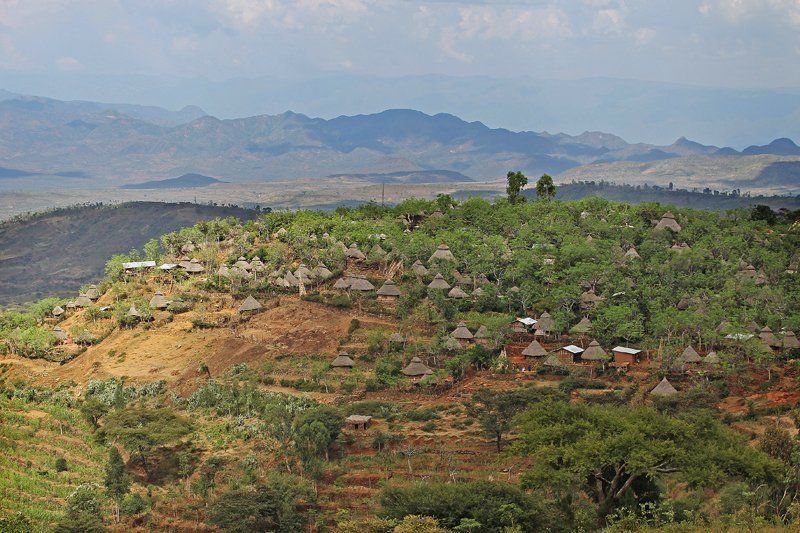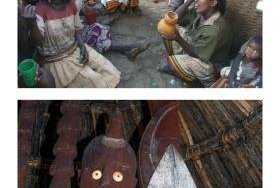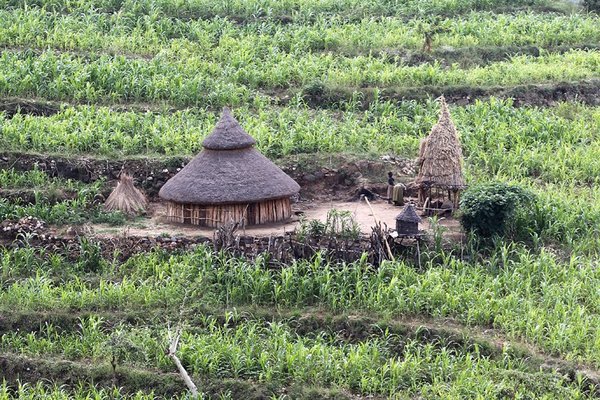Ethiopia
Konso
Konso Cultural Landscape represents a traditional way of living known for its construction of dry stone terraces and fortified towns.
The Konso people migrated to these highlands, where they constructed terraces to support agricultural fields. Their cultural tradition has existed for over 400 years in a hostile, dry environment. The area has 12 stone-walled settlements with thatch-roofed public structures and domestic buildings. The Konso are noted for their erection of memorial stelae called waka.
Community Perspective: Solivagant describes the history of its WH inscription and his visit to a village in 2007, while Wojciech visited Gamole village in 2022.
Site Info
Official Information
- Full Name
- Konso Cultural Landscape (ID: 1333)
- Country
- Ethiopia
- Status
-
Inscribed 2011
Site history
History of Konso
- 2011: Advisory Body overruled
- ICOMOS recommended deferral -boundaries, integrity, were "unable" to send a mission. Mal, Nig, Egy, RSA, Jor lead for inscription. Sui, Swe et al against. Secret ballot 14/5 in favour with 1 abst.
- 2011: Inscribed
- Inscribed
- 2010: Referred
- Type
- Cultural
- Criteria
- iii
- v
Links
- UNESCO
- whc.unesco.org
- Official
-
- visitethiopia.travel — Visit Ethiopia Konso
- Related
-
- christensenfund.org — Includes a nice video
All Links
UNESCO.org
- whc.unesco.org — whc.unesco.org/
Official Website
- visitethiopia.travel — Visit Ethiopia Konso
Related Resources
- christensenfund.org — Includes a nice video
Community Information
- Community Category
- Cultural Landscape: Continuing
Travel Information
Recent Connections
-
Honey Collection
"There is a tradition of constructing … -
Megalithism
The tradition of erecting generation ma… -
Ratites
Somali ostrich
Connections of Konso
- Individual People
-
-
Sir Wilfred Thesiger
Thesiger suggested the tribe for an anthropological Phd thesis "While enquiring about the possibilities of fieldwork in Ethiopia, Wilfred Thesiger drew his attention to the Konso, among whom Hallpike lived from 1965-67. His doctoral research was published in 1972 as The Konso of Ethiopia. A study of the values of a Cushitic people." From his photo collection:
-
- Trivia
-
-
Minority communities
Konso
-
- History
-
-
Megalithism
The tradition of erecting generation marking stones called daga-hela, quarried, transported and erected through a ritual process, makes the Konso one of the last megalithic people. (Description)
-
- Ecology
-
-
Ratites
Somali ostrich
-
- Architecture
-
-
Dry Stone Construction
dry stone walls (AB ev) -
Vernacular architecture
-
- World Heritage Process
-
-
Controversial at inscription
ICOMOS recommended deferral -boundaries, integrity, were "unable" to send a mission. Mal, Nig, Egy, RSA, Jor lead for inscription. Sui, Swe et al against. Secret ballot 14/5 in favour with 1 abst,
-
- Religion and Belief
-
-
Sacred Forests or Groves
three main sacred Poqolla forests (AB ev) -
Living indigenous religions
-
- Human Activity
-
-
Honey Collection
"There is a tradition of constructing houses on a single log of tree in these towns. These houses are called Lokutatokide. They often serve to store precious items such as butter, honey, and important cultural and ritual objects." (nom file) and from the linked web site "They are also renowned bee-keepers; the bees produce acacia honey, which is also exported to Europe" -
Coffee
Coffee, cotton and chat are cash crops (AB ev) -
Man-made Terraces
-
- Constructions
- Timeline
-
-
Built in the 17th century
People moved there ca. 400 years ago (AB ev)
-
News
No news.
Recent Visitors
Visitors of Konso
- Alexander Barabanov
- Ali Zingstra
- amychemu
- Ana Lozano
- Astraftis
- Atila Ege
- Bamse
- Boj
- David Marton
- Eva Kisgyorgy
- Fan Yibo
- Gernot
- Harry Mitsidis
- Jarek Pokrzywnicki
- John Smaranda
- La Concy
- Loic Pedras
- Luis Filipe Gaspar
- marcel staron
- Marcobrey
- Martin
- Morodhi
- Nihal Ege
- Philipp Leu
- Piotr Wasil
- Randi Thomsen
- Solivagant
- Svein Elias
- Szucs Tamas
- Thomas Buechler
- Timothy C Easton
- tony0001
- Westwards
- Wojciech Fedoruk
Community Reviews
Show full reviews
Site visited in November 2022. During my trip to Ethiopia, I visited the village of Gamole, which is a living open-air museum and a monument to the culture of the Konso people. Within three lines of stone walls (once protecting against wild animals and invaders, today only of symbolic meaning) people live mainly engaged in farming on the terraces, which are a symbol of the region. Such terraces are commonplace in the Philippines, China or Vietnam, but in Ethiopia they are a real revolution - only the Konso have transformed the landscape in this way, other tribes have treated the mountains as a demarcation line, and only goats graze there from economic activities.
Our fixer arranged a guide with whom we safely explored the village. From the guide we know that the Konso people are divided into 9 clans, and marriage is allowed only with a person from another clan. The people are ruled by a king, and when he dies, everyone pretends to be sick. They embalm the corpse and keep it for 9 years, 9 months and 9 days, and only after this period they stop pretending and celebrate the coronation of the new king, the eldest son of the predecessor. What if there is no son? I don't know, we didn't go into details about Konso's succession rights.
The people are also known for putting so-called waka, wooden monuments in memory of rulers and other distinguished figures. And in the center of the village he …
Keep reading 0 comments
Konso is very special place for me! especially for its settings and natural gifts and talents of the residents. As one one of konso people I feel proud of being from land with such type of natural blessings and from a society with such type of talents. i.e tracing, wood curving(waka), conflict resolution techniques. this is just to say a little of what Konso is endowed with.
Keep reading 0 comments
As we visited the Konso area of S Ethiopia in Dec 2007 we will be particularly interested to see what actually emerges within the nomination which is currently foreseen for 2010. The description on Ethiopia’s T List entry of 1997 isn’t that exciting – “Konso-Gardula (paleo-anthropological site)….. discovered in 1991. The sites are dated to be between 200.000 and 2000000 years old…. Early and middle pleistocene animals and hominides fossils along with early Acheulian and Oldowan cultural materials ….. Twelve individual hominides identified to be Homo erectus and Australopithicus Boisei…”. Ethiopia already has 2 paleo-anthropological sites inscribed at Lower Awash and Omo and also had another at Melka Kunture deferred in 1980 (which we also saw). Clearly Ethiopia is important for its central role within the East African “Cradle of Mankind” and can be rightly proud of such remains as have been found within its boundaries – but can it be making too much of a “good thing”?
In fact, subsequent documents seem to suggest that the nominated site will cover rather more than these “paleo anthropological remains”. The first is dated 1999 when UNESCO granted $15000 for “Preparatory Assistance - Konso Cultural Landscape”. The documentation states “The Konso region is known for the recent discovery of 17 paleo-anthropological sites dated from the middle and lower Pleistocene age. It is also a remarkable landscape which contains outstanding geo-morphological features, sacred forests and stone terraces”. By 1999 we have a presentation by Yonas Beyune at a “World Heritage Convention and Cultural …
Keep reading 0 comments
